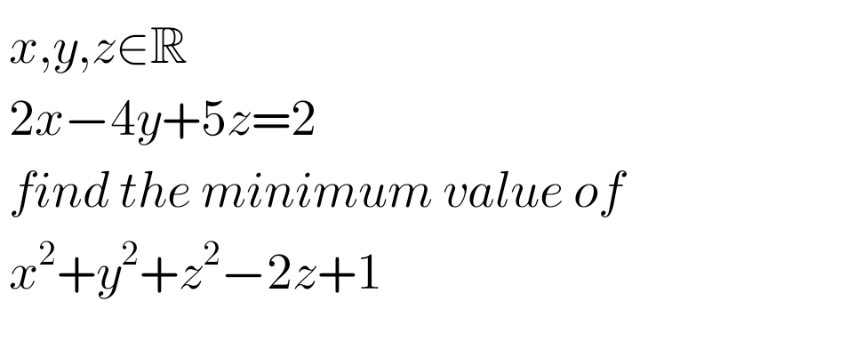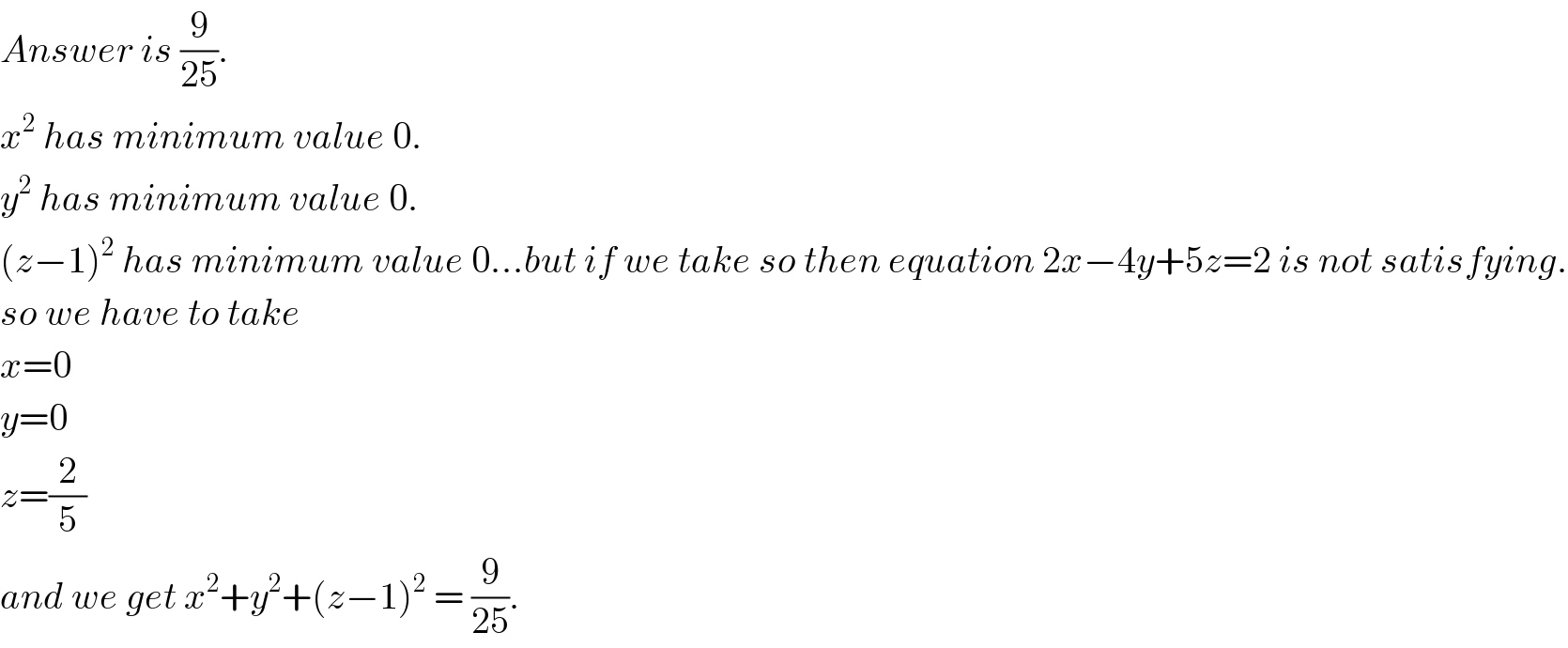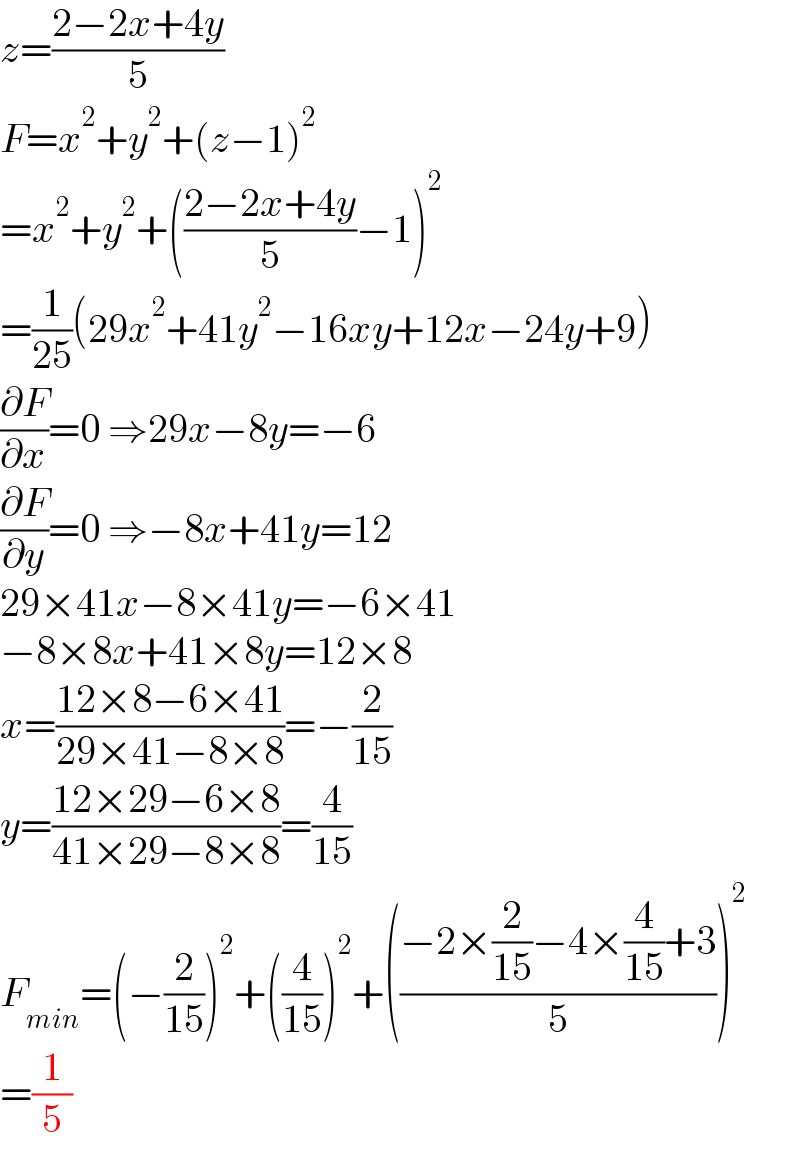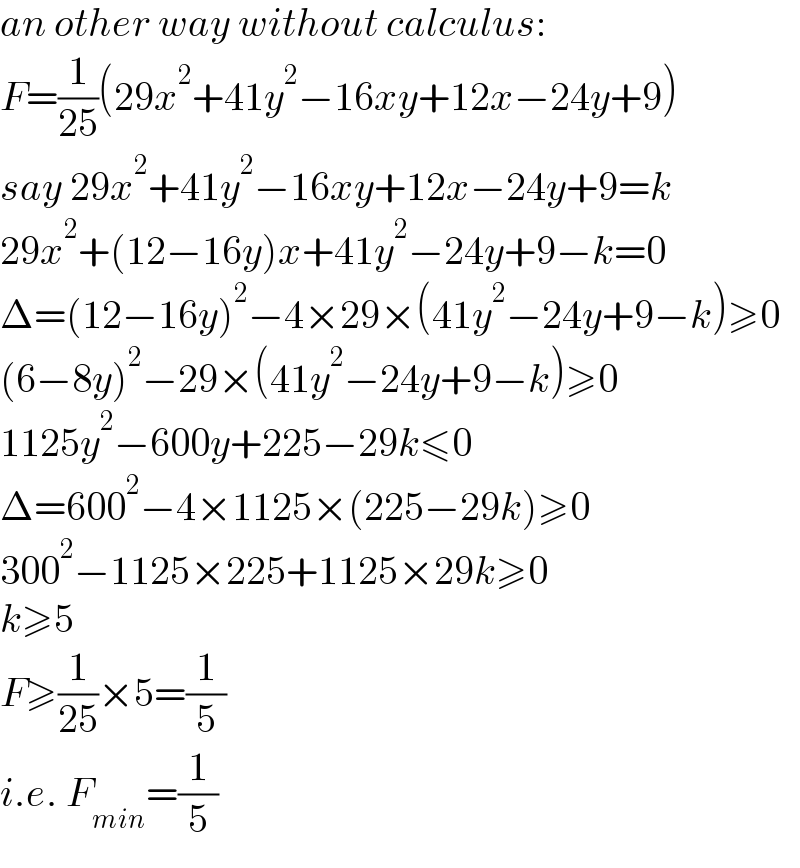
Question Number 140367 by aliibrahim1 last updated on 06/May/21

Answered by meetbhavsar25 last updated on 06/May/21

$${Answer}\:{is}\:\frac{\mathrm{9}}{\mathrm{25}}. \\ $$$${x}^{\mathrm{2}} \:{has}\:{minimum}\:{value}\:\mathrm{0}. \\ $$$${y}^{\mathrm{2}} \:{has}\:{minimum}\:{value}\:\mathrm{0}. \\ $$$$\left({z}−\mathrm{1}\right)^{\mathrm{2}} \:{has}\:{minimum}\:{value}\:\mathrm{0}...{but}\:{if}\:{we}\:{take}\:{so}\:{then}\:{equation}\:\mathrm{2}{x}−\mathrm{4}{y}+\mathrm{5}{z}=\mathrm{2}\:{is}\:{not}\:{satisfying}. \\ $$$${so}\:{we}\:{have}\:{to}\:{take}\: \\ $$$${x}=\mathrm{0} \\ $$$${y}=\mathrm{0} \\ $$$${z}=\frac{\mathrm{2}}{\mathrm{5}} \\ $$$${and}\:{we}\:{get}\:{x}^{\mathrm{2}} +{y}^{\mathrm{2}} +\left({z}−\mathrm{1}\right)^{\mathrm{2}} \:=\:\frac{\mathrm{9}}{\mathrm{25}}. \\ $$
Commented by aliibrahim1 last updated on 06/May/21

$${thx}\:{dir}\:{appreciate}\:{it} \\ $$
Commented by aliibrahim1 last updated on 06/May/21

$${your}\:{answer}\:{is}\:{incorrect}\:{sir} \\ $$
Commented by meetbhavsar25 last updated on 07/May/21

$${What}\:{is}\:{the}\:{answer}? \\ $$
Commented by meetbhavsar25 last updated on 07/May/21

$${Okay}....{i}\:{got}\:{the}\:{answer}\:\frac{\mathrm{1}}{\mathrm{5}} \\ $$
Commented by aliibrahim1 last updated on 07/May/21

$${yes}\:{correct} \\ $$
Answered by mr W last updated on 06/May/21

$${z}=\frac{\mathrm{2}−\mathrm{2}{x}+\mathrm{4}{y}}{\mathrm{5}} \\ $$$${F}={x}^{\mathrm{2}} +{y}^{\mathrm{2}} +\left({z}−\mathrm{1}\right)^{\mathrm{2}} \\ $$$$={x}^{\mathrm{2}} +{y}^{\mathrm{2}} +\left(\frac{\mathrm{2}−\mathrm{2}{x}+\mathrm{4}{y}}{\mathrm{5}}−\mathrm{1}\right)^{\mathrm{2}} \\ $$$$=\frac{\mathrm{1}}{\mathrm{25}}\left(\mathrm{29}{x}^{\mathrm{2}} +\mathrm{41}{y}^{\mathrm{2}} −\mathrm{16}{xy}+\mathrm{12}{x}−\mathrm{24}{y}+\mathrm{9}\right) \\ $$$$\frac{\partial{F}}{\partial{x}}=\mathrm{0}\:\Rightarrow\mathrm{29}{x}−\mathrm{8}{y}=−\mathrm{6} \\ $$$$\frac{\partial{F}}{\partial{y}}=\mathrm{0}\:\Rightarrow−\mathrm{8}{x}+\mathrm{41}{y}=\mathrm{12} \\ $$$$\mathrm{29}×\mathrm{41}{x}−\mathrm{8}×\mathrm{41}{y}=−\mathrm{6}×\mathrm{41} \\ $$$$−\mathrm{8}×\mathrm{8}{x}+\mathrm{41}×\mathrm{8}{y}=\mathrm{12}×\mathrm{8} \\ $$$${x}=\frac{\mathrm{12}×\mathrm{8}−\mathrm{6}×\mathrm{41}}{\mathrm{29}×\mathrm{41}−\mathrm{8}×\mathrm{8}}=−\frac{\mathrm{2}}{\mathrm{15}} \\ $$$${y}=\frac{\mathrm{12}×\mathrm{29}−\mathrm{6}×\mathrm{8}}{\mathrm{41}×\mathrm{29}−\mathrm{8}×\mathrm{8}}=\frac{\mathrm{4}}{\mathrm{15}} \\ $$$${F}_{{min}} =\left(−\frac{\mathrm{2}}{\mathrm{15}}\right)^{\mathrm{2}} +\left(\frac{\mathrm{4}}{\mathrm{15}}\right)^{\mathrm{2}} +\left(\frac{−\mathrm{2}×\frac{\mathrm{2}}{\mathrm{15}}−\mathrm{4}×\frac{\mathrm{4}}{\mathrm{15}}+\mathrm{3}}{\mathrm{5}}\right)^{\mathrm{2}} \\ $$$$=\frac{\mathrm{1}}{\mathrm{5}} \\ $$
Commented by mr W last updated on 06/May/21

$${an}\:{other}\:{way}\:{without}\:{calculus}: \\ $$$${F}=\frac{\mathrm{1}}{\mathrm{25}}\left(\mathrm{29}{x}^{\mathrm{2}} +\mathrm{41}{y}^{\mathrm{2}} −\mathrm{16}{xy}+\mathrm{12}{x}−\mathrm{24}{y}+\mathrm{9}\right) \\ $$$${say}\:\mathrm{29}{x}^{\mathrm{2}} +\mathrm{41}{y}^{\mathrm{2}} −\mathrm{16}{xy}+\mathrm{12}{x}−\mathrm{24}{y}+\mathrm{9}={k} \\ $$$$\mathrm{29}{x}^{\mathrm{2}} +\left(\mathrm{12}−\mathrm{16}{y}\right){x}+\mathrm{41}{y}^{\mathrm{2}} −\mathrm{24}{y}+\mathrm{9}−{k}=\mathrm{0} \\ $$$$\Delta=\left(\mathrm{12}−\mathrm{16}{y}\right)^{\mathrm{2}} −\mathrm{4}×\mathrm{29}×\left(\mathrm{41}{y}^{\mathrm{2}} −\mathrm{24}{y}+\mathrm{9}−{k}\right)\geqslant\mathrm{0} \\ $$$$\left(\mathrm{6}−\mathrm{8}{y}\right)^{\mathrm{2}} −\mathrm{29}×\left(\mathrm{41}{y}^{\mathrm{2}} −\mathrm{24}{y}+\mathrm{9}−{k}\right)\geqslant\mathrm{0} \\ $$$$\mathrm{1125}{y}^{\mathrm{2}} −\mathrm{600}{y}+\mathrm{225}−\mathrm{29}{k}\leqslant\mathrm{0} \\ $$$$\Delta=\mathrm{600}^{\mathrm{2}} −\mathrm{4}×\mathrm{1125}×\left(\mathrm{225}−\mathrm{29}{k}\right)\geqslant\mathrm{0} \\ $$$$\mathrm{300}^{\mathrm{2}} −\mathrm{1125}×\mathrm{225}+\mathrm{1125}×\mathrm{29}{k}\geqslant\mathrm{0} \\ $$$${k}\geqslant\mathrm{5} \\ $$$${F}\geqslant\frac{\mathrm{1}}{\mathrm{25}}×\mathrm{5}=\frac{\mathrm{1}}{\mathrm{5}} \\ $$$${i}.{e}.\:{F}_{{min}} =\frac{\mathrm{1}}{\mathrm{5}} \\ $$
Commented by aliibrahim1 last updated on 07/May/21

$${thx}\:{sir}\:{really}\:{appreciate}\:{it} \\ $$
